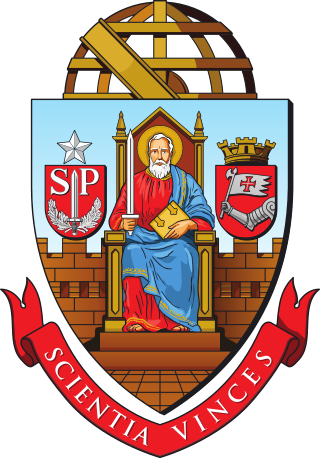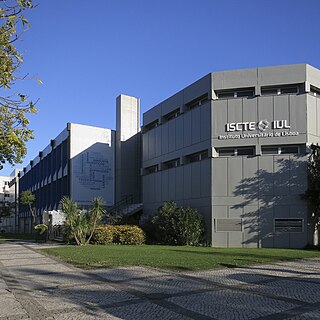
The University of São Paulo is a public university in the Brazilian state of São Paulo. It is the largest Brazilian public university and one of the country's most prestigious educational institutions. USP is involved in teaching, research and university extension in all areas of knowledge, offering a broad range of courses.

The University of Coimbra is a public research university in Coimbra, Portugal. First established in Lisbon in 1290, it went through a number of relocations until moving permanently to Coimbra in 1537. The university is among the oldest universities in continuous operation in the world, the oldest in Portugal, and played an influential role in the development of higher education in the Portuguese-speaking world. In 2013, UNESCO declared the university a World Heritage Site, noting its architecture, unique culture and traditions, and historical role.

The Federal University of Rio Grande do Sul is a Brazilian public federal research university based in Porto Alegre, Rio Grande do Sul. UFRGS is among the largest and highest-rated universities in Brazil, having one of the largest number of scientific publications. From 2012 to 2019, the university was elected as the best federal university of Brazil. UFRGS has over 31,000 undergraduate students, over 12,000 graduate students, and more than 2,600 faculty members. As a Brazilian public federal institution, students do not pay tuition fees to enroll in courses offered by the university.

The Instituto Superior Técnico is the school of engineering and technology of the University of Lisbon. It was founded as an autonomous school in 1911, and was integrated into the Technical University of Lisbon in 1930. IST is the largest school of engineering in Portugal by number of enrolled students, faculty size, scientific production and patents.

NOVA University Lisbon, or just NOVA, is a Portuguese public university whose rectorate is located in Campolide, Lisbon. Founded in 1973, it is the newest of the public universities in the Portuguese capital city, earning its name as the "New" (NOVA) University of Lisbon.

The Technical University of Lisbon was a Portuguese public university. It was created in 1930 in Lisbon, as a confederation of preexisting schools, and comprised the faculties and institutes of veterinary medicine; agricultural sciences; economics and business administration; engineering, social and political sciences; architecture; and human kinetics.

São Paulo State University is a public university run by the state government of São Paulo, Brazil.
Higher education in Portugal is divided into two main subsystems: university and polytechnic education. It is provided in autonomous public and private universities, university institutes, polytechnic institutes and higher education institutions of other types.

The Instituto de Medicina Molecular João Lobo Antunes, or iMM for short, is an associated research institution of the University of Lisbon, in Lisbon, Portugal.

The University of Cape Verde is the only public university of Cape Verde. The main campus is in Palmarejo, Praia, but there are also institutes in Mindelo, Assomada and São Jorge dos Órgãos. It has over 5000 students. A new campus for Uni-CV is under construction in Palmarejo, financed by the Chinese government. It should be completed by July 2020. It will have capacity for 4,890 students and 476 professors, with a library, dorms, cafeterias and sports facilities. It will have 61 class rooms, five auditoriums with a capacity of 150 seats, eight computer rooms, eight reading rooms and 34 laboratories.

ISCTE – Instituto Universitário de Lisboa is a Portuguese public tertiary education institution. It is located in the city centre of Lisbon, in Cidade Universitária, adjoining the Institute of Social Sciences (ICS) and Institute of Geography and Spatial Planning (IGOT) of the University of Lisbon. ISCTE was founded in 1972, starting with three degrees and 296 studentes. Formerly called Instituto Superior de Ciências do Trabalho e da Empresa, its full name was dropped in 2009 when it became a university institute of foundational nature.

The Interactive Technologies Institute is a teaching and research institute of the Instituto Superior Técnico, which has its headquartered located in Lisbon, Portugal.
The University of Porto is a Portuguese public research university located in Porto, and founded on 22 March 1911. It is the second largest Portuguese university by number of enrolled students, after the University of Lisbon, and has one of the most noted research outputs in Portugal.

The University of Lisbon was a public university in Lisbon, Portugal. It was founded in 1911 after the fall of the Portuguese monarchy and was later integrated in the new University of Lisbon along with the former Technical University of Lisbon.
The Instituto Superior de Ciências Sociais e Políticas (ISCSP) is part of the University of Lisbon (ULisboa). It was known in the early 20th century as the Colonial School, when it was run by the Geographical Society of Lisbon. In 2016, ISCSP celebrated 110 years of continuous operation. As a higher education institution, ISCSP aims to equip students with skills in the cultural, scientific and technical fields; conduct fundamental and applied research; provide community service; and promote exchanges in the social and political sciences.
GASTagus, also known as Grupo de Ação Social do Tagus, is a Portuguese non-governmental development organization (NGDO).

The Faculty of Pharmacy, Universidade de Lisboa (FFUL) is a Portuguese public institution of higher education dedicated to education, research, knowledge transfer and continuing education in the fields of pharmacy, medicine, and pharmaceutical sciences.

ISPA – Instituto Universitário is a private research university institute located in Lisbon. Founded in 1962 as Instituto de Ciências Psicopedagógicas, it was the first institution of higher education in the area of psychology in Portugal. According to the Academic Ranking of World Universities, ISPA is among the top 400 universities in the world in the field of psychology.
Maria Amélia de Sousa Ferreira Chaves de Almeida Fernandes was a Portuguese civil engineer. She was the first female civil engineer to graduate from the Instituto Superior Técnico of the Universidade Técnica de Lisboa. She is considered to be the first Portuguese woman to graduate and then work in civil engineering, and the first Portuguese female engineer to work in the field.




















